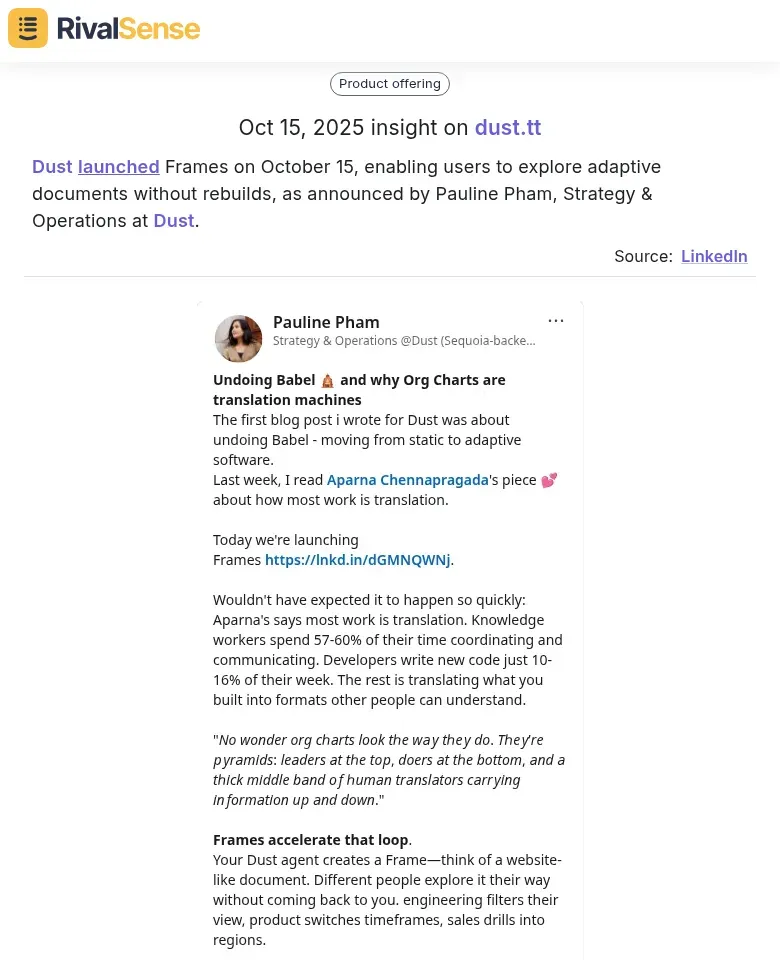How to Leverage Competitor Insights: Analyzing Dust's Frames Launch
Competitor analysis is essential for any business aiming to stay competitive and agile in a dynamic market. By systematically tracking your rivals' activities, you can uncover opportunities, mitigate threats, and refine your own strategic decisions. This process involves monitoring various elements such as product innovations, pricing strategies, and public announcements to build a comprehensive view of the competitive landscape.
Gathering timely and accurate insights allows you to anticipate market shifts and respond proactively. For instance, knowing when a competitor launches a new feature can help you assess its potential impact on your customer base and adjust your offerings accordingly.
Real-World Example: Dust's Launch of Frames
Let's examine a concrete example to illustrate the power of effective competitor monitoring. Recently, Dust introduced a new capability called Frames, which enables users to explore adaptive documents without requiring rebuilds. This launch was announced on October 15 by Pauline Pham, who leads Strategy & Operations at Dust, highlighting their focus on enhancing user experience and productivity.

Such insights, when captured early, can reveal a competitor's strategic priorities and innovation pace. By analyzing this information, you can gauge how Dust's move might influence industry standards or customer expectations, allowing you to prepare counter-strategies or identify areas for collaboration.
Practical Tips for Effective Competitor Monitoring
To make competitor analysis actionable, it's crucial to adopt a structured approach that integrates both manual and automated methods. Start by identifying key competitors and the specific aspects of their business that matter most to your strategy, such as product updates, leadership changes, or market expansions.
Here are some practical steps to enhance your monitoring efforts:
- Set Up Alerts and Feeds: Use tools to receive notifications on competitor website changes, social media posts, and news mentions. This ensures you don't miss critical updates like Dust's Frames announcement.
- Analyze Announcements for Strategic Clues: Pay attention to who is making the announcements—for example, Pauline Pham's role in Dust's launch can indicate the strategic importance of the feature. Look for patterns in timing, messaging, and target audience.
- Leverage Consolidated Insights Platforms: Consider using services that aggregate data from multiple sources, such as RivalSense, which tracks product launches, pricing updates, partnerships, and more. This saves time and provides a holistic view.
To help you stay organized, here's a simple checklist for routine competitor tracking:
- [ ] Review competitor websites and blogs weekly for new content or features.
- [ ] Monitor social media channels and industry forums for real-time updates.
- [ ] Subscribe to industry reports or tools that automate data collection and analysis.
- [ ] Document insights in a shared repository for team discussion and action planning.
Enhancing Your Strategy with Automated Tools
Manual tracking can be overwhelming and prone to missing key details, especially with multiple competitors and data sources. Automated solutions like RivalSense streamline this by compiling information from company websites, social media, registries, and the broader internet into regular email reports.
By incorporating such tools, you can quickly access insights similar to the Dust Frames example, enabling faster decision-making. For instance, RivalSense covers product launches, pricing changes, event participations, partnerships, regulatory updates, management shifts, and media mentions, giving you a 360-degree view of competitor movements.
Try out RivalSense for free at https://rivalsense.co/ to simplify your competitor analysis and get your first report today—empower your business with timely, data-driven insights!
📚 Read more
👉 Free Competitor Analysis Tools: The Ultimate Guide to Staying Ahead in 2025
👉 How Media Buying Agencies Win with Competitor Customer Service Insights
👉 How Merchize's $2.5 Flash Card Launch Fueled Competitor Growth
👉 Case Study: Website Changes Reveal Competitor Market Research
👉 Best Practices for Beauty Retail Key Account Health Dashboards
